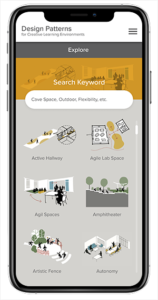 By James Seaman, PhD, AIA, ALEP
By James Seaman, PhD, AIA, ALEP
Managing Partner & Michigan Studio Director, Fielding International
Creating learning environments in schools that support a district’s educational vision can be a complicated task. Many schools still feature traditional spaces that were designed around a learning model that emphasized the delivery of content. However, the vision for learning has shifted to activities that focus on building skills along with developing a deeper understanding of content. New ideas are needed for creating learning environments in schools that support students engaged in a variety of activities.
 Ideas for creating these new learning environments can be explored through Design Patterns. Design Patterns are ideas that provide the visual representation of how a space works. These key ideas break down the complexity of school design as part of a system. Through the use of Patterns we can easily identify problems, opportunities and solutions to design and connect successful educational environments and experiences. Design Patterns take an idea and make it visual so that we can more easily “see” what is important. Sometimes we will see a very large school make use of up to 20+ Patterns.
Ideas for creating these new learning environments can be explored through Design Patterns. Design Patterns are ideas that provide the visual representation of how a space works. These key ideas break down the complexity of school design as part of a system. Through the use of Patterns we can easily identify problems, opportunities and solutions to design and connect successful educational environments and experiences. Design Patterns take an idea and make it visual so that we can more easily “see” what is important. Sometimes we will see a very large school make use of up to 20+ Patterns.
The 70+ of Fielding International’s Design Patterns shared on SchoolPatterns.com have been used in the planning and design of schools around the world. Design Patterns can help from the beginning stages of a school design through visioning and ideation, to the preparation of educators on how to use the built space effectively and maximize the learning experience. Having Design Patterns as a resource at each stage in the process improves the quality of understanding and communication, which in turn aligns the goal to design a school where learners thrive.
At Fielding, Design Patterns have been foundational to the way we think about school design. In 2005, we published the book The Language of School Design to share our ideas. Since then, we’ve learned from and evolved our Patterns, along with creating many new ones, and as our commitment to making a positive social impact and designing schools where learners thrive continues, this next iteration of Design Patterns shared freely on SchoolPatterns.com reflects our collaborative efforts—how we use them, how our clients use them, and how we offer them as a resource to the world.
This open-source library was specifically designed to jumpstart innovation by sharing our latest school design thinking and we invite Michigan’s educational leaders to search, learn, and share these illustrations with others to spur conversation, create excitement, and identify spatial opportunities.
